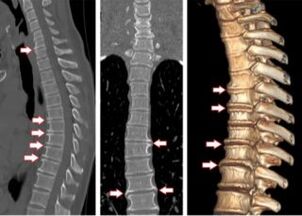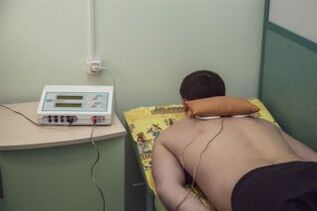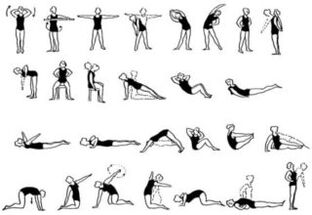Osteochondrosis is the leading cause of back pain. The thoracic spine is affected less frequently than other parts, initially being less mobile. Due to the lack of characteristic symptoms, degenerative disease is more difficult to diagnose. Premature treatment brings serious consequences.
Degrees and symptoms of osteochondrosis

Dystrophic lesions of bone and cartilage tissue are the most common chronic human diseases. The pathological process begins with the nucleus of the intervertebral disc, then spreads to the annulus fibrosus. Atrophied cartilage loses its cushioning properties and the load on the bone increases. The gap between the vertebrae narrows, extensions and hernias appear, the nerve endings are stuck.
Symptoms of pathology:
- dorsalgia (back pain), aggravated by body movement, touching, deep sighing and coughing;
- discomfort in the sternum on the left side, shortness of breath, feeling of a lump in the throat;
- excessive sweating;
- feeling of numbness of a part of the skin and limbs;
- painful sensations in the xiphoid process, extending to the shoulder blades and arms;
- dorsago - acute chest pain when you are in a position for a long time.
Irritation of receptors in the spine in the chest area is manifested by impulses that mimic heart disease. This pseudo-coronary pain is called anterior chest wall syndrome. The pain on the left side lasts for weeks, not relieved by cardiac medication. At the same time, the ECG does not show violations in the work of the organ.
The symptoms of the disease are often similar to other pathologies. Patient complaints may indicate heart failure or gastrointestinal problems. Only a comprehensive examination will help establish the correct diagnosis.
The clinical picture of the disease varies depending on the compression or non-compression forms of osteochondrosis. When nerve endings are compressed, pain, numbness, muscle weakness, and difficulty moving occur. The non-compressive form is manifested by acute or chronic pain syndrome in the affected area of the back, as well as reflex pain in the region of the heart, stomach, liver. Clinical signs of pathology vary depending on the stage of the disease and the age of the person.
Uncharacteristic symptoms of breast osteochondrosis include pain sensations in women in the mammary gland, brittle nails, and scaly skin. The disease is caused by pregnancy. At this time, the female body experiences increased stress on the spine and lack of nutrients.
In men, compression of the nerve roots in the lower thoracic region leads to discomfort in the groin area, kidney pain.
Degrees of osteochondrosis
Depending on the condition of the cartilage tissue, there are 4 stages of the disease:
- Grade 1 - at an early stage of the disease, cracks appear in the annulus fibrosus. The pulposus nucleus emerges through them. There is discomfort in the sternum, in the heart area. This stage is characterized by pain withdrawal and muscle spasms.
- 2 degree - the situation is aggravated by pathological mobility of the vertebrae. A sign of this stage is increased pain when you move and are in a position for a long time. Bead subluxation is possible.
- Grade 3 - the structure of the spine is severely damaged, the fibrous ring is completely ruptured. Defeat of nerve endings leads to intercostal neuralgia. A person's mobility is limited, he takes a forced stay. The pain radiates to the internal organs, abdomen, limbs.
- 4 degree - the structures surrounding the spine are involved in the pathological process. Excessive growth of scar tissue leads to ligament fibrosis. A severe neurological reaction requires regular use of supportive medications.
Early diagnosis of the disease can slow the destruction of intervertebral discs. In the early stages, treatment is more effective. With prolonged back pain and the appearance of other symptoms of osteochondrosis, you should consult a neurologist.
A delayed visit to the hospital leads to dangerous complications. These include herniated discs, inflammation of nerve endings, proliferation of osteophytes, paresis. With increasing bone formations, there is a high risk of damage to the spinal canal tissue. The dystrophic processes initiated are the complete destruction of the vertebra. The patient can only be helped by surgery.
Causes and risk factors
The movable spine of the cervix and lumbar spine are most often affected by the disease. The thoracic region is reinforced with ribs, which reduces the risk of pathology, but does not exclude its appearance. The disease can occur at any age. Its ICD 10 code is M42. 14 - osteochondrosis of the spine in adults with localization in the chest region. For adolescent patients, there is a special code - M42. Poor posture, kyphosis or scoliosis are provocative factors for the onset of the disease in young people.
The main causes of the disease
Degenerative changes in the intervertebral discs occur with insufficient nutrition. The pulposus nucleus loses its ability to distribute the load evenly, and cracks appear in the fibrosus rings. Doctors believe that a common cause of pathology is a genetic predisposition to osteochondrosis. Other factors include:
- sedentary lifestyle and sedentary work;
- spinal cord injury;
- infectious diseases;
- increased physical activity;
- hormonal disorders;
- weak muscular corset.
The exact cause of the onset of degenerative changes cannot be determined. The disease can be recognized by objective signs and symptoms. People who spend a lot of time in a sitting position, have behavioral problems and spinal injuries should be especially attentive to their manifestations.

Provocative factors
The natural tendency towards cartilage dystrophy may not appear until middle age, when the natural aging process of the body begins. But there are factors that can provoke accelerated degeneration. This includes:
- chronic stress;
- hypothermia;
- unbalanced diet;
- difficult working conditions;
- obesity
With prolonged pinching and inflammation of the nerve roots, disturbances in the work of internal organs occur. Osteochondrosis is characterized by a wavy course, periods of acute or dull pain are replaced by remission.

Diagnostic methods
To establish a diagnosis, you will need to collect the patient's history, perform a physical examination. A preliminary conclusion is made during the initial exam. The patient's spine is examined in different positions. Confirmation of pathology and information about the condition of the spine is provided by instrumental diagnosis. Experts use:
- Radiography. Photographs of the thoracic region show the degree of pathology. Direct and lateral radiography helps to establish a change in disc height, the appearance of osteophytes, the compression of the end plates of the vertebral body, the narrowing of the spinal canal diameter, and the formation of Schmorl joints.
- Computed tomography is performed to detect and measure bone structures.
If necessary, magnetic resonance imaging is prescribed.
Treatment and prevention
Get rid of pain, inflammation and other problems is possible only with complex treatment. The choice of technique depends on the patient's condition. In the initial stages, conservative therapy is practiced; in advanced cases, surgical intervention will be required.
medications
A course of medication is prescribed to eliminate the pain and prevent further destruction of the intervertebral disc structures. The basis of therapy is non-steroidal anti-inflammatory drugs. They are prescribed in the form of tablets and oils.
For the treatment of 3 degrees of osteochondrosis, hormonal drugs - corticosteroids are used. They have a pronounced anti-inflammatory effect. In acute pain syndrome, anesthetic injections are indicated. Muscle spasms and tension are relieved by muscle relaxants. To restore cartilage tissue, experts advise the use of chondroprotectors.
Healing inflammation of nerve roots is facilitated by taking special vitamin complexes containing B vitamins. Beneficial elements are well absorbed from food - eggs, plants, beef and cheese. The patient is advised to rest and rest. He should observe bed rest in the early days.

Physiotherapy
The effect of the apparatus has a pronounced therapeutic effect. Patients with osteochondrosis are prescribed:
- shock wave therapy;
- electrophoresis;
- ultrasonic exposure;
- magnetotherapy;
- laser therapy.
Physiotherapy increases blood flow and relaxes muscles. During electrophoresis sessions, the drugs penetrate deeper into the body tissues.
Folk remedies
You can be treated not only with medicine, but also with the help of folk remedies. At home, various herbs and foods can be used as cures. Boils, oils, rubs are prepared from them. The tools allow alleviate inflammation, accelerate regeneration processes. A warm bath with sea salt and chamomile helps relieve pain. Effective recipes:
- Juniper and butter ointment - Beat the crushed juniper with butter until softened. The composition is stored in the refrigerator.
- Pork heat ointment and hop cones - dried cones are ground to a powder and mixed with fat. Ointment is applied 2-3 times a day.
- Honey compress - for the composition you need 2 tablespoons of honey, 2 tablespoons of vodka, 1 tablespoon of aloe juice. The products are mixed and applied to the affected area.
- Mustard compress - vodka, camphor alcohol and mustard powder are mixed in equal proportions. Add 3 proteins and incubate for 12 hours. The product has an irritating effect, so it is used with caution.
Before using the formulations, doctors advise you to check them for an allergic reaction.
Massage
One of the parts of the complex treatment of osteochondrosis of the thoracic spine is massage. The procedure reduces pain, increases blood circulation and stimulates muscles. Applicants can replace massage and acupuncture at home. These are special carpets with plastic needles.

Physiotherapy
When the period of deterioration is over, it is recommended to switch to light physical activity. These include walking, swimming, yoga and improving gymnastics. Performing a special set of exercises is the easiest way to cope with an illness and forget about back problems forever. During exercise, the emphasis is on stretching and strengthening the chest muscles. There is a special technique that helps to improve the health of the spine. Exercises are selected according to the individual characteristics of the patient.
Preventive recommendations
Doctors advise, as a prevention of the disease, to regularly perform a series of exercises aimed at strengthening the muscles of the back and chest. In addition to gymnastics, you must adhere to the following rules:
- Take breaks while doing sedentary work. Change your posture often so that the load is distributed to different muscle groups.
- Choose a comfortable orthopedic mattress for a good spine rest.
- Use a chair with a high back that supports the back.
- Balance your diet.
- Refuse to lift and carry weights.
A timely visit to a doctor allows you to diagnose osteochondrosis at an early stage. This gives a favorable prognosis for recovery.



































